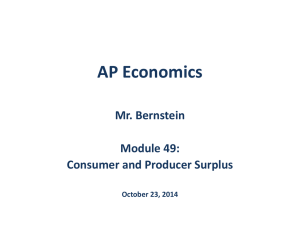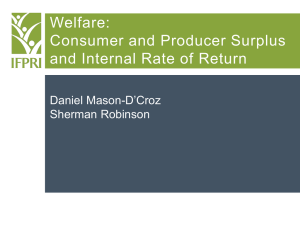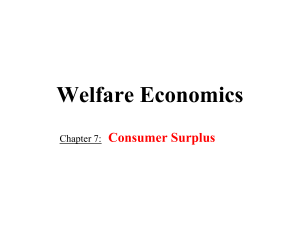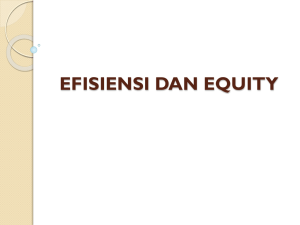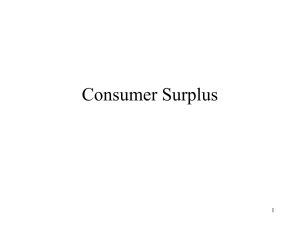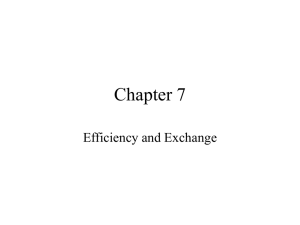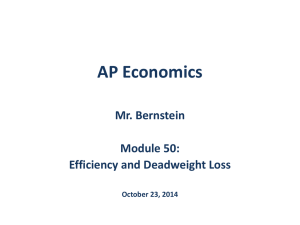Welfare Analysis
advertisement
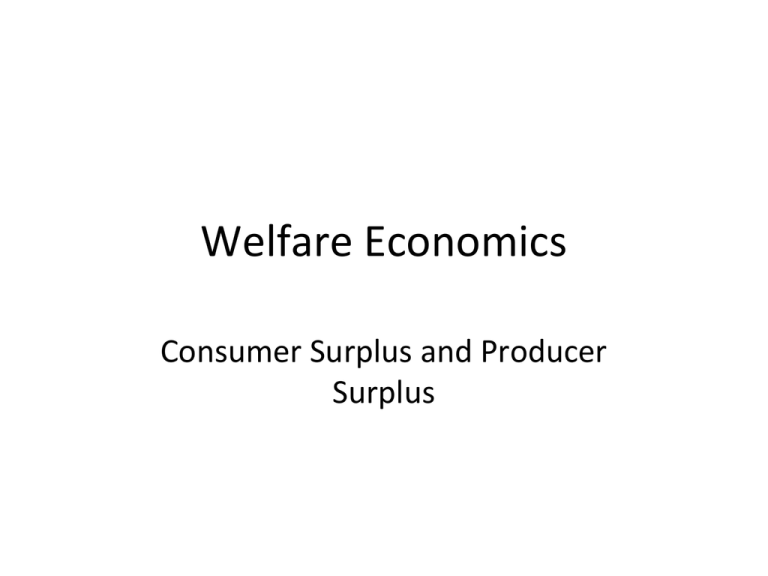
Welfare Economics Consumer Surplus and Producer Surplus Revisiting The Market Equilibrium • The theory of supply and demand shows how markets allocate scarce resources among competing needs. • But are the equilibrium price and the equilibrium quantity the right price and the right quantity from society’s point of view? • This question takes us into welfare economics. 2 Welfare Economics • Welfare economics is the study of how the allocation of resources affects economic wellbeing • It shows that: – Both buyers and sellers receive benefits from taking part in the market – The equilibrium outcome in the theory of supply and demand maximizes the total welfare of buyers and sellers 3 Two main concepts • When buyers and sellers trade willingly, it must be because they expect to benefit • Consumer surplus measures economic welfare of the buyers. • Producer surplus measures economic welfare of the sellers. 4 CONSUMER SURPLUS 5 Willingness to pay • To define consumer surplus we first need to define “willingness to pay.” • Willingness to pay is the maximum amount that a buyer will pay for a good. • It measures how much the buyer values the good. 6 Willingness to pay: background • Assume there is a commodity such that every additional unit of it increases a consumer’s happiness by the same amount – In other words, the consumption of additional units of this commodity induces neither boredom nor addiction – Possible examples: potato chips? candy? • Then the consumer’s willingness to pay for a product is a good measure of the happiness that he or she gets from it 7 Willingness to pay: background • Suppose a bag of potato chips provides a fixed amount of happiness • If your willingness to pay is – 4 bags of potato chips for a shirt, and – 2 bags of potato chips for a cup of coffee, then – one can safely say that the shirt makes you twice as happy as the cup of coffee • So, your willingness to pay for a commodity is a good measure of how much you like it 8 Willingness to pay: background • If the dollar price of a bag of potato chips is known, willingness to pay in the example above can also be expressed in dollars 9 Willingness to pay: background • Another example: – if you are willing to pay $15 for a shirt, and – if a bag of potato chips • always gives you 3 “haps” of happiness, and • sells at the price of $0.50 each, then – the shirt gives you 90 “haps” of happiness. 10 Willingness to pay: background • In other words, your willingness to pay for the shirt is – a monetary measure of the happiness you get from the shirt, and – it is proportional to the happiness you get from the shirt, as measured in “haps” 11 Table 1 Four Possible Buyers’ Willingness to Pay For a mint-condition recording of Elvis Presley’s first album I will illustrate consumer surplus through this extended example. 12 Consumer Surplus • Consumer surplus is the buyer’s willingness to pay for a good minus the amount the buyer actually pays for it. – Example: If the Elvis album’s price is $75… Buyer Willingness to Pay Consumer Surplus Buy? John 100 25 Yes Paul 80 5 Yes George Ringo 70 50 -5 -25 No No 13 Market Demand • The market demand shows the quantities demanded by buyers at different prices. • We can use the willingness-to-pay numbers to calculate the market demand – See the next slide 14 The Demand Schedule Buyer Willingness to Pay John 100 Paul 80 George 70 Ringo 50 15 Figure 1 The Demand Curve Price of Album Buyer Willingness to Pay John 100 Paul 80 George 70 John’s willingness to pay $100 Ringo Paul’s willingness to pay 80 George’s willingness to pay 70 Ringo’s willingness to pay 50 Demand 0 50 1 2 3 4 The height of the demand curve at any quantity shows the willingness to pay of whoever bought the last unit. Quantity of Albums 16 Copyright©2003 Southwestern/Thomson Learning Area of a Rectangle Area = Width × Height Height Width 17 Figure 2 Measuring Consumer Surplus with the Demand Curve Buyer Willingness (b) Price = $70.01 Price of Album $100 Buy? to Pay Consumer Surplus John 100 30 Yes Paul 80 10 Yes George 70 0 No Ringo 50 -20 No 1. The area under the demand curve measures the total willingness to pay for the quantity demanded. 80 70 50 2. It is also the maximum willingness to pay that could be generated from that quantity. Demand 0 John’s willingness to pay 1 4 Quantity of Albums Paul’s willingness to pay 2 3 20 Interpersonal comparability • We just saw – that the total area under the demand curve is $180, and – that is also the total willingness to pay of John and Paul • But can we say it is the total happiness of John and Paul? 21 Interpersonal comparability • Yes, – if there is a commodity—say, a bag of potato chips—that provides an unchanging amount of happiness to the consumer, and – if John’s happiness and Paul’s happiness are comparable, and – if both John and Paul get the same happiness from a bag of potato chips • That’s a lot of if’s! • But we will make these simplifying assumption anyway – Not just for John and Paul, but for everybody 22 Utilitarianism • The idea that – the happiness of an individual can be measured numerically, – the happiness of a group of people can be measured numerically, – the happiness of a group of people is simply the sum of the numbers representing the happiness of the individual members of the group, and that – social policy should seek to maximize the total happiness of society, – is called utilitarianism • Welfare analysis in this course takes utilitarianism as its guiding philosophy 23 The market and the planner • Suppose the government has two copies of the Elvis album. The government’s goal is to give them to two of the four guys so as to generate the maximum happiness. • Who will get the government’s copies? • Obviously, John and Paul, same as in the market outcome we saw before. • So, the market does the best that the government could have done Price = $70 Buyer Willingness to Pay John 100 Paul 80 George 70 Ringo 50 24 Willingness to Pay from the Demand Curve Price A P1 B C The area under the demand curve measures the total willingness to pay of the consumers who bought Q1 units. It also measures the maximum willingness to pay that could be obtained from Q1 units Demand 0 Q1 Quantity 25 Using the demand curve to measure willingness to pay • In general, the area under the demand curve up to the quantity demanded is a graphical measure of the total willingness to pay of the buyers. • It is also the maximum willingness to pay that can be obtained from that quantity – That is, the government could not give away that quantity in a way that generates higher willingness to pay. 26 Figure 3 How the Price Affects Consumer Surplus (a) Consumer Surplus at Price P Price A Consumer Surplus (ABC) + Total Payment (OBCQ1) = Willingness to Pay (OACQ1) Consumer surplus P1 B C Total Payment 0 Demand Q1 Quantity 30 Using the Demand Curve to Measure Consumer Surplus • In general, the area below the demand curve and above the price measures the consumer surplus. 31 Figure 3 How the Price Affects Consumer Surplus (b) Consumer Surplus at Price P Price A Initial consumer surplus P1 P2 0 C B Consumer surplus to new consumers F D E Additional consumer surplus to initial consumers Q1 Demand Q2 Quantity 32 Shifts in Demand • We know that the demand curve can shift, for reasons such as – a change in tastes, and – a change in the prices of related goods • Given that the demand for a product can shift as a result of a change in the price of a related good, does it make sense to say that the area under the demand curve measures the happiness consumers get from the product? 33 Shifts in Demand • Continued from the previous slide • Yes! – Keep in mind that the area under the demand curve is a monetary measure of the happiness obtained by buyers – The objective or psychological happiness obtained from a shirt may be unchanged even if the monetary willingness to pay for the shirt changes, perhaps because of a change in the price of a related good • In an earlier slide, a bag of potato chips was assumed to always provide 3 “haps” of happiness, and sold at a price of $0.50. Consequently, consumers were wiling to pay $15 for a shirt that provided 90 “haps” of happiness. • It follows that if the price of a bag of potato chips rises to $1, consumers would then be willing to pay $30 for the same shirt, leading to an upward shift in the demand curve for shirts. 34 PRODUCER SURPLUS 35 Producer Surplus • Producer surplus is the amount a seller is paid for a good minus the seller’s cost. • It measures the net benefit to sellers • It is almost but not quite the same as profit. 36 Cost of production • The cost of production is the market value of all resources used in production – By all, I do mean all. – Even if some resources used in production were obtained for free, their market value must be included in cost. 37 Table 2 The Cost of Painting a House for Four Possible Sellers 38 Costs → Supply • The supply of house painting services shows the quantity of house painting services supplied at all possible prices • The cost numbers in the previous slide can be used to calculate supply of house painting services 39 Costs → Supply Seller Cost ($) Mary 900 Frida 800 Georgia 600 Grandma 500 40 Figure 4 The Supply Schedule and the Supply Curve The height of the supply curve at any quantity shows the production cost to whoever produces the last unit. Seller Cost ($) Mary 900 Frida 800 Georgia 600 Grandma 500 41 Producer Surplus • Producer surplus is the amount a seller is paid minus the seller’s cost – Example: If the going price for getting a house painted is $700 we get the following table. Seller Cost ($) Producer Surplus Sell? Mary 900 -200 No Frida 800 -100 No 100 200 Yes Yes Georgia 600 Grandma 500 42 Using the Supply Curve to Measure Producer Surplus • The area below the price and above the supply curve measures the producer surplus. 43 Figure 5 Measuring Producer Surplus with the Supply Curve (b) Price = $799.99 Price of House Painting Supply 1. The area under the supply curve is the cost of the quantity supplied 2. It is also the lowest cost for that quantity $900 800 600 500 0 1 Grandma’s cost Georgia’s cost 2 3 Seller Cost ($) Producer Surplus Sell? Mary 900 -100 No Frida 800 0 No Georgia 600 200 Yes Grandma 500 300 Yes 4 Quantity of Houses Painted 48 Is there a better alternative to the market system? • If the government had to get two houses painted, who would get the job? • Grandma and Georgia, of course. • And, as we just saw, that’s exactly what happens in the market outcome. • So, the market achieves the best that the government could have achieved Seller Cost ($) Mary 900 Frida 800 Georgia 600 Grandma 500 49 Figure 5 Measuring Producer Surplus with the Supply Curve 1. The rectangular (b) Price = $800 Price of House Painting $900 area under the price and up to the quantity supplied is Supply the Total Revenue. Total producer surplus ($500) 2. The area under the price and above the supply is the Producer Surplus. 800 Seller Cost ($) Producer Georgia’s producer Surplus surplus ($200) Mary 900 -100 600 500 Grandma’s producer surplus ($300) 0 1 2 3 Sell? No Frida 800 0 No Georgia 600 200 Yes Grandma 500 300 Yes 4 Quantity of Houses Painted 50 Figure 6 How the Price Affects Producer Surplus (a) Producer Surplus at Price P Price Supply P1 B Producer surplus A 0 C Total Revenue (OBCQ1) = Production Cost (OACQ1) + Producer Surplus (ABC) Production Cost Q1 Quantity 51 Figure 6 How the Price Affects Producer Surplus (b) Producer Surplus at Price P Price Supply Additional producer surplus to initial producers P2 P1 D E F B Initial producer surplus C Producer surplus to new producers A 0 Q1 Q2 Quantity 52 Figure 7 Consumer and Producer Surplus in the Market Equilibrium Price A D Supply Consumer surplus Equilibrium price E Producer surplus B Demand C 0 Equilibrium quantity Quantity 53

